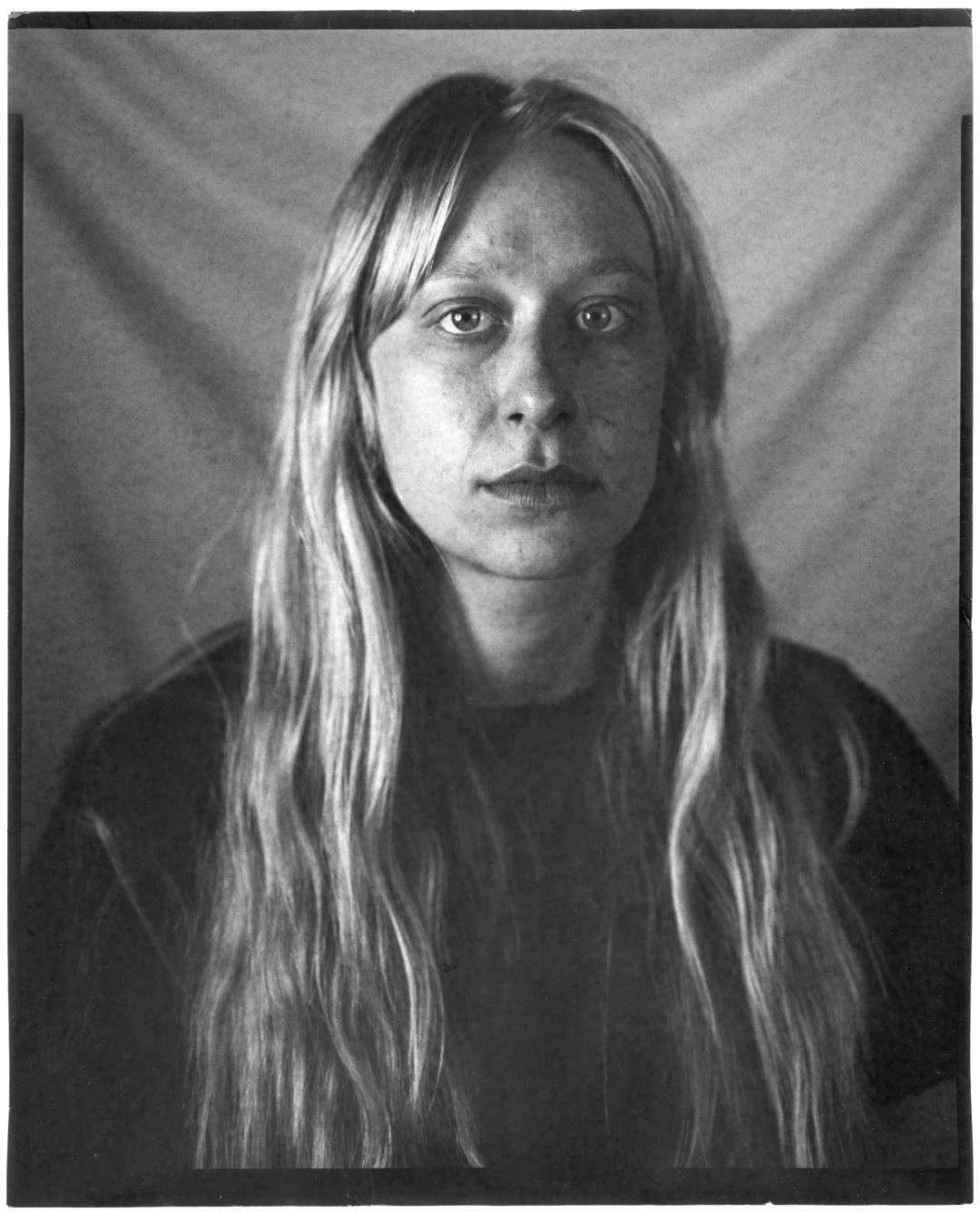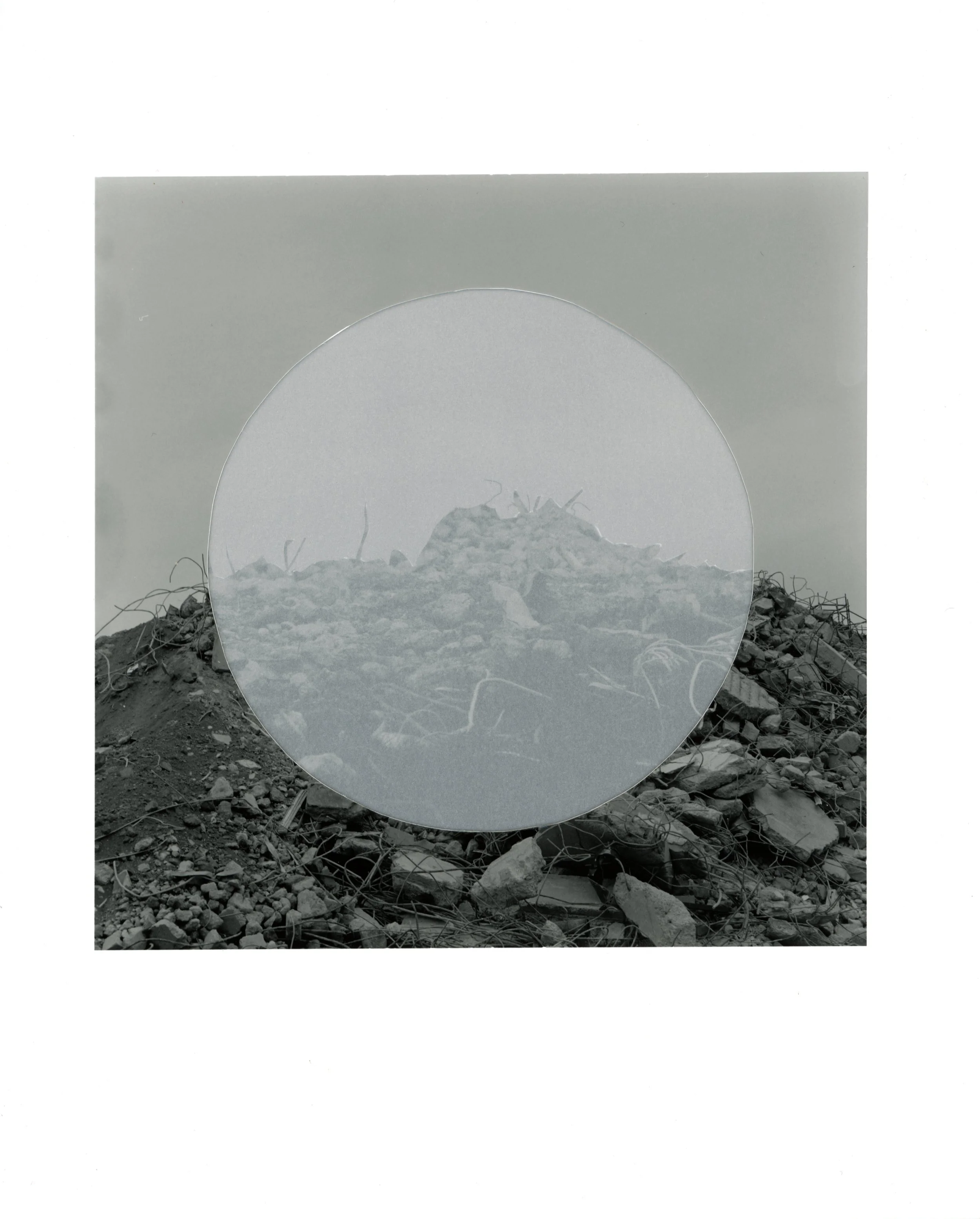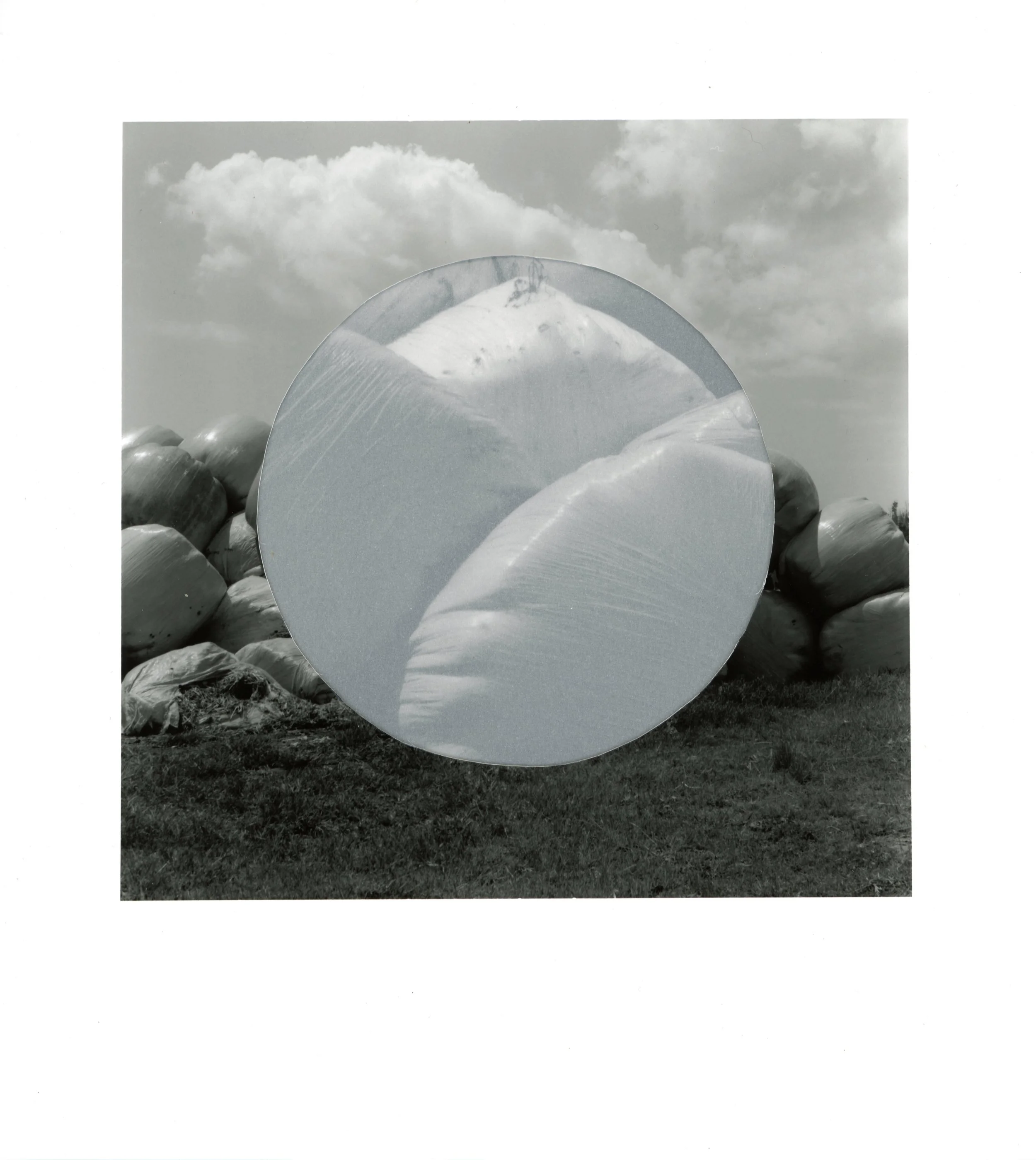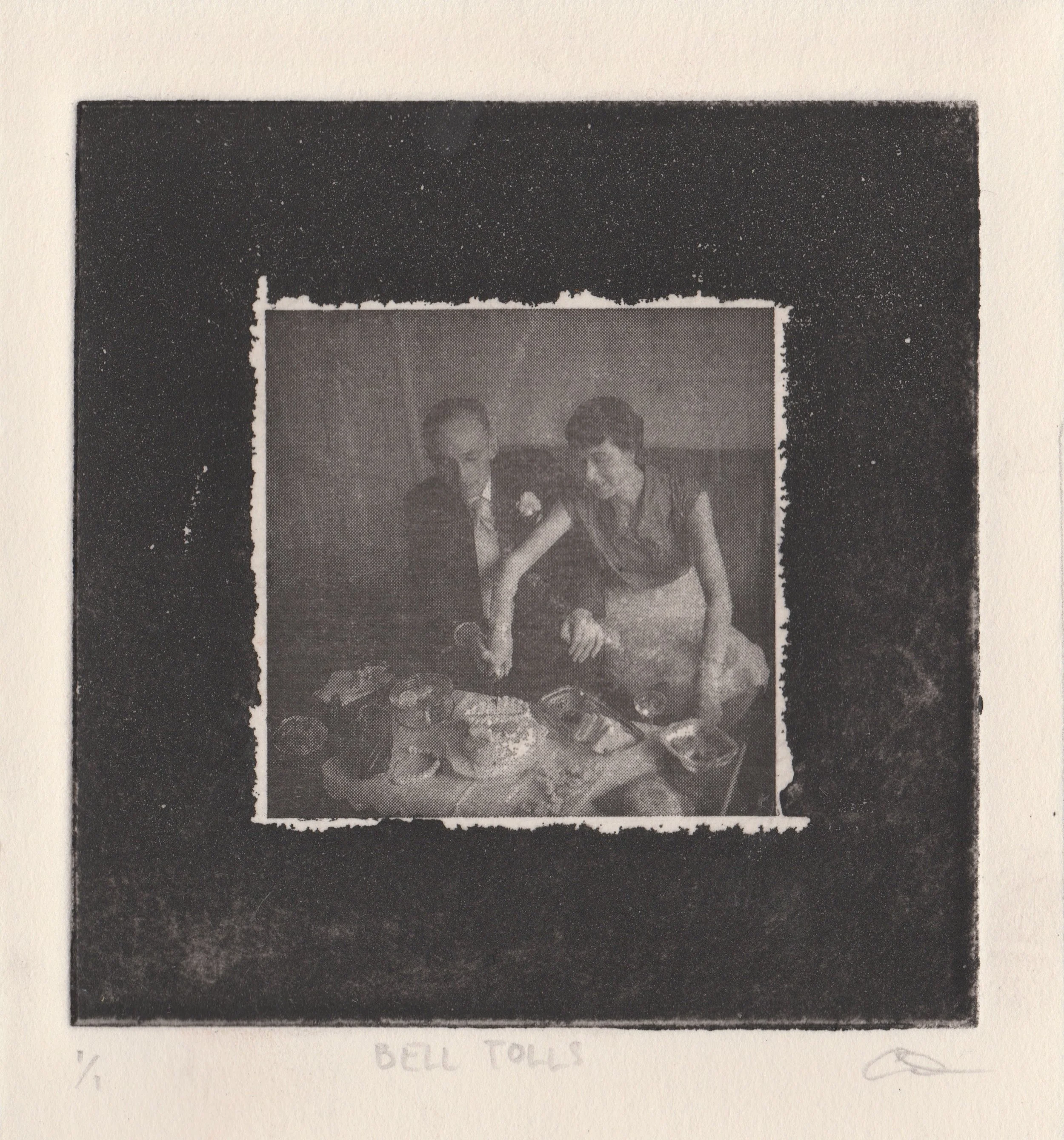Photography by Greg Stoodley.
Claire Fletcher
Claire Fletcher is a visual artist practicing on Ngunnawal Country, ACT, Australia. Working across painting, photography and print media, Fletcher explores the themes of sensation, memory and emotional experience.
Fletcher is completing her Bachelor of Visual Arts at the Australian National University (ACT), majoring in Printmedia and Drawing. Recent exhibitions include ANU SOAD Grad Show 2024 (2024), Immaterial 3.0 (2023), and View 2021 (2021). Her work resides in both domestic and international private collections.
Claire Fletcher, Rural Asphyxiation (detail), 2024, oil on silver gelatin print, 25.4 × 20.4 cm. Image courtesy of the artist.
Tell us about your creative process. What drives your practice?
My creative process generally starts with an inkling, a sensation. I am a sporadic and lazy artist who likes to simultaneously flirt with different ideas and mediums. I produce a lot of intuitive experiments, which generally result in a bunch of bad scraps that never see the light of day. I then take the experiments that hold my interest and refine them. After a while, and a few bad ideas on top of one another, the work starts realising itself. It's a conversational back-and-forth.
As a lazy artist here are a few tips to battle the mental resistance in the studio;
Keep a clean studio. I like to reset my space at the end of each session
Do a mind-dump writing exercise before tucking in.
No scrap or experiment is too ‘bad’ – keep them all.
Get amongst the community studios, share knowledge, engage with others, and battle the echo chamber of self.
What drives my practice? I'm unsure if it’s necessity, habit, compulsion or obsession. I haven't quite put my finger on it yet, but I try not to question it.
Printmaking has continued to find its way into your work, whether in or out of the print studio. How does print permeate your photographic practice?
Printmaking has taught me patience, discipline and sensitivity. It gave me a foundation for understanding layering, colour interaction, texture and tactility. Printmaking taught me to look for things that fall through the cracks – light, patterns, impressions, shapes. How to reduce, strip back, and re-build an image. Printmaking gave me the confidence to experiment non-judgmentally.
For example, without my background in printmaking, I don't think I would have ‘had the guts’ to approach my recent project Rural Asphyxiation (2024). The work presents a collection of hand-manipulated photographic darkroom prints bound into a unique state artist's book. Print-media processes informed how I approached preparing, sequencing and executing the project. The book-binding process was an experimental undertaking that merged my photographic, painterly and printmaking practices. I stayed open to outcomes that happened by chance. Working intuitively, I explored a hybrid of experimental manipulations such as hand colouring, geometric cut-outs and layered imagery to obscure and activate the images from my archive.
Claire Fletcher, Rural Asphyxiation (installation view), 2024, unique state artists book, oil paint silver gelatin prints, vellum paper, card, vinyl, string, 26 x 20.8 x 5 cm. Image courtesy of the artist.
Claire Fletcher, Rural Asphyxiation (detail), 2024, unique state artists book, oil paint silver gelatin prints, vellum paper, card, vinyl, string, 26 x 20.8 x 5 cm. Photography by Brenton McGeachie.
What is the role of ‘method-based-play’ as an approach to making and how does this manifest within your artistic output?
Method-based play keeps me hungry. It provides me with a framework for iterative image generation, allowing me to be curious and experiment whilst pursuing technical and aesthetic growth. Play is such an important sentiment in my practice. I use it as a form of self-permitance, granting myself space to test new techniques and ideas without judgment.
My practice has been largely influenced by my time spent working in the darkroom and print studios. I am drawn to technical processes, and fascinated by the potential outcomes and visual qualities that differing techniques can yield. I’m always eavesdropping or looking over someone's shoulders to learn a new technique or way of seeing.
How does the audience’s experience of an artist's book communicate your explorations of memory and archive?
I’ve had a special fascination with books, ever since I was a child. Furthermore, I've always loved photo books – even photobooks that weren't strictly photobooks; encyclopedias, manuals, and even junk mail. There's something very precious about the immersive experience of a book. The tactile physicality invites intimate engagement with the work, encouraging the audience to step closer, look harder, draw connections and create narratives.
From its conception photography has been used as a surrogate memory device, which appeals to me as someone living with P.T.S.D. Rural Asphyxiation (2024) explores the relationship between photography, memory and trauma, re-presenting the images from my archive in an intentionally ambiguous way. By physically intervening in the surfaces of the photographs, the images mimic the fragmented nature of memories, capturing the essence and experience of place.
Claire Fletcher, Untitled, 2024, silver gelatin prints and tracing paper, 25.4 x 20.4 cm. Image courtesy of the artist.
Claire Fletcher, Untitled, 2024, silver gelatin prints and tracing paper, 25.4 x 20.4 cm. Image courtesy of the artist.
Are there any female printmakers | artists that influence you?
I am surrounded by such a fantastic and supportive creative community of women. I'd like to take a moment to thank;
Dr Rebecca Mayo, who taught me to invest in myself and my work.
Odette England, who taught me to find perfection in the imperfect.
Katrina Sluis, who taught me to never take myself too seriously.
Emma Beer, who taught me to stick to my guns (and how to stretch canvas).
I'm currently reading Paintings: Mysteries & Confessions (2010) by Tess Jaray which explores her inspirations, processes, thematics and challenges of artistic expression. The book is written in a devourable manner that reveals her intellectual and emotional motivations within her work.
Finally, what exciting projects are you working on?
I'm starting to work on another book, surprise, surprise. With my residency opportunity at Megalo (thank you Megalo Print Studio!) I will be stepping back into the print studio this year.
I want to investigate scale more intentionally, expanding and restricting the image – but that's yet to be decided. I'm excited to play with the intersections between print media and photography, particularly photogravure and laser etching methods.
Currently, I have an installation piece, Red Light District (2025), on show in CHUTESPACE until Sunday 16 February.
Coming up I have three new paintings I'm super stoked with on display on Sunday 23rd February as a part of Moonlighting 2 here in Canberra – I would love to see you there.
Cheers!
Claire Fletcher, Untitled, 2023, silver gelatin print, 25.4 x 20.4 cm. Image courtesy of the artist.
Claire Fletcher, Bell Tolls, 2022, laser zinc etching on Hahnemuhle paper, 10 x 10 cm.Image courtesy of the artist.











